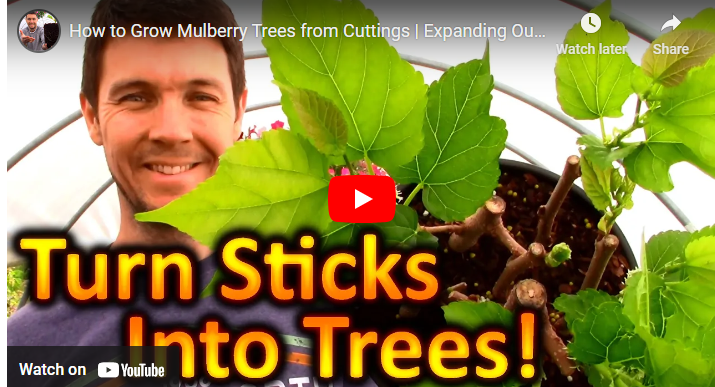Mulberry trees are delightful fruit-bearing plants that can bring beauty and abundant harvests to your garden. While growing mulberry trees from seeds is possible, propagating them from cuttings is a popular and efficient method.
To grow a mulberry tree from a cutting, select a healthy stem cutting with several nodes, remove the lower leaves, dip the cut end in rooting hormone, plant it in well-drained soil or a pot with a rooting medium, keep it consistently moist and in a warm location, and wait for roots to develop before transplanting it to its permanent location for further growth and care.
In this step-by-step guide, we will explore how to grow mulberry trees from cuttings in Australia, enabling you to enjoy the process of nurturing and watching your own mulberry tree thrive.
How to Grow Mulberry Tree from Cutting in Australia: Step by Step Guide
Before diving into the propagation process, it’s important to have a basic understanding of mulberry trees. Mulberry trees belong to the Moraceae family and are native to Asia, Africa, and the Americas. They are known for their fast growth, tolerance to various soil types, and ability to adapt to different climates.
Growing mulberry trees from cuttings offers several advantages. Firstly, it allows you to reproduce desirable qualities from a parent tree. Additionally, the success rate is higher compared to growing from seeds. By following the steps below, you can increase your chances of successfully growing a mulberry tree from a cutting.
Step 1: Choosing the Right Cutting
To start the propagation process, you’ll need to select a healthy cutting. Look for a branch that is approximately 10-15 centimeters long, preferably from the current year’s growth. Ensure that the cutting has at least two nodes, which are the points where leaves and buds emerge.
Step 2: Preparing the Cutting
Once you’ve obtained the cutting, remove any leaves from the bottom half. This will prevent excessive moisture loss during the rooting process. If the cutting has large leaves, you can trim them to reduce the strain on the cutting.
Step 3: Rooting the Cutting
To encourage root growth, you can use a rooting hormone powder or gel. Dip the bottom end of the cutting into the rooting hormone, tapping off any excess. Then, place the cutting in a well-draining potting mix, burying it about halfway. Mist the cutting with water and cover it with a plastic bag to create a humid environment.
Step 4: Transplanting the Cutting
After a few weeks, check for root development by gently tugging on the cutting. If you feel resistance, it indicates that roots have formed. At this stage, it’s time to transplant the cutting into a larger pot or directly into the ground. Ensure that the new location provides ample sunlight and well-drained soil.
Step 5: Caring for the Young Mulberry Tree
Once the cutting has been transplanted, it requires proper care to ensure healthy growth. Water the tree regularly, ensuring the soil remains moist but not waterlogged. Mulching around the base of the tree will help retain moisture and suppress weeds. Prune any damaged or crossing branches to maintain a balanced shape.
Step 6: Pruning and Maintenance
As the mulberry tree grows, it’s important to prune it regularly to promote air circulation and encourage fruit production. Pruning during the dormant season helps shape the tree and remove any dead or diseased branches. Additionally, mulberry trees benefit from annual fertilization to ensure adequate nutrients for optimal growth.
Common Problems and Troubleshooting
While growing mulberry trees from cuttings is relatively straightforward, you may encounter some challenges along the way. One common issue is root rot caused by overwatering or poorly draining soil.
To avoid this, make sure the soil has good drainage and only water when the top inch of soil is dry. Pests, such as aphids or whiteflies, can also affect mulberry trees. Regularly inspect the leaves and treat any infestations promptly with organic or chemical solutions.
Can I grow a mulberry tree from seeds instead of cuttings?
Yes, you can grow a mulberry tree from seeds. However, propagating from cuttings is often a more reliable method to reproduce desirable qualities.
How long does it take for a mulberry cutting to root?
On average, it takes around 3-4 weeks for a mulberry cutting to develop roots. However, the rooting time can vary depending on environmental conditions.
Do I need to use rooting hormone for mulberry cuttings?
While not mandatory, using a rooting hormone can enhance the success rate of rooting mulberry cuttings.
Can I grow mulberry trees in pots?
Yes, mulberry trees can be grown in pots. Ensure that the pot has sufficient drainage holes and choose a suitable dwarf or container-friendly variety.
What is the best time to take mulberry cuttings? The best time to take mulberry cuttings is during late winter or early spring when the tree is dormant and before new growth begins.
Conclusion
Growing mulberry trees from cuttings can be a rewarding experience, allowing you to propagate your own trees with ease. By following the step-by-step guide outlined above, you’ll increase your chances of success and enjoy the benefits of having a flourishing mulberry tree in your Australian garden. Start your journey to growing mulberry trees today and savor the delicious fruits they yield.




